
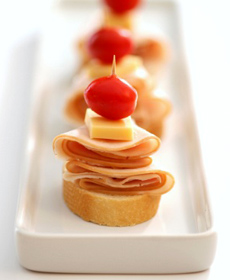
Gouda pairs with ham, chicken or marinated vegetables to make tasty hors d’oeuvres. Photo by Branislav Senic | IST.
|
STEPHANIE ZONIS, Contributing Editor, focuses on good foods and the people who produce them.
|
|
February 2008
|
 |
The Case for Gouda, Part 2
Tasting, Pairing & Serving Holland’s Most Famous Cheese
- Click here to read other months’ Whey To Go columns
CAPSULE REPORT: In Part 1 of this article, we looked at the history of Gouda, how it is made, and the difference between young and aged Goudas. While some cheese connoisseurs dismiss Gouda as a simple snack-and-sandwich cheese (and the young Goudas are lovely for this purpose), aged Goudas are a different proposition altogether. Deep caramel in color, crunchy, flaky, and meltingly smooth on the tongue, a true cow's milk Dutch Gouda bursts with flavor. The older the cheese, the more wonderful the flavors of butterscotch and caramel.
Now that you understand what Gouda is all about (from Part 1 of this article), it’s time to “taste” Gouda. First, let’s look at what to do with it.
Food & Beverage Pairings
If you’re not sure of uses for this cheese beyond a table cheese (a.k.a. the cheese board) and snacking, there are many!
- Beverages. Cheese expert Steven Jenkins recommends beer as the ideal alcoholic accompaniment to a young Gouda and light red or fruity white wines as
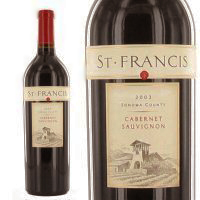 the drink of choice with a more mature cheese. For the aged Goudas, our wine editor likes an aged White Burgundy or Chardonnay, which has butterscotch and caramel tones that match those in the aged Gouda; or a dry Riesling. For reds, try a heartier fruity reds, including Cabernet Sauvignon, Merlot, Syrah, Shiraz and Zinfandel. Our editorial director enjoyed St. Francis Sonoma County Cabernet Sauvignon, with black cherry fruit flavor, dark chocolate notes and spicy oak that gave off butterscotch tones unusual in a red wine, and perfect with Gouda. the drink of choice with a more mature cheese. For the aged Goudas, our wine editor likes an aged White Burgundy or Chardonnay, which has butterscotch and caramel tones that match those in the aged Gouda; or a dry Riesling. For reds, try a heartier fruity reds, including Cabernet Sauvignon, Merlot, Syrah, Shiraz and Zinfandel. Our editorial director enjoyed St. Francis Sonoma County Cabernet Sauvignon, with black cherry fruit flavor, dark chocolate notes and spicy oak that gave off butterscotch tones unusual in a red wine, and perfect with Gouda.
- Bread & Sandwiches. All types of Goudas go well with fruit and good bread (an aged Gouda would pair more successfully with a heavier or whole grain bread, however). Gouda melts well, so it can grace a sandwich as a “melt” in addition to its regular form. Try a Gouda and apple grilled-cheese sandwich, or a ham and cheese using speck, an Italian cross between prosciutto and bacon (photo at right—it is dry cured and smoked and cured before it is sold, and requires no cooking afterward—if you can’t find it locally, order it from iGourmet.com). Add some roasted red peppers or pimentos to the sandwich for a gourmet experience.
|
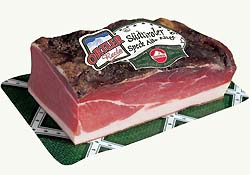
While you’re trying great Gouda, try some speck, too. This dry-cured bacon (no cooking required) will impress in sandwiches, hors d’oeuvres, on pizza (sure, grate some Gouda on that pizza) and many other dishes.
|
- Recipes. There are myriad recipes online that call for Gouda, from a Gouda fondue to Gouda cheese grits. As with any fine cheese, you can make canapés, as shown in the photo at the top of the page (chicken breast, Gouda and a grape tomato on a slice of baguette with Lemonaise or Latin Lemonaise from The Ojai Cook).
- Vegetables. Grate an aged Gouda on cooked vegetables, into potato and rice dishes.
Gouda is seen as lowly among serious cheese epicures, who fancy the more elegant Bries, blues, and complex washed-rind cheeses. But Gouda’s reputation as the cheese to have with a sausage and beer is not entirely deserved. Most people only know it through the mass-produced supermarket variety; few critics have had an exciting aged, artisan Gouda. Try a few Goudas produced by people who really care about what they’re doing, and you’ll notice the differences.
Tasting The Goudas
This is a random sampling of the many Goudas (and types of Goudas) available. As is usual with my sit-down, focused tastings, I made sure I had a quiet time to conduct them. My stomach was neither full nor empty. All cheeses were allowed to come to room temperature before tasting.
All Goudas in this tasting were made from cow’s milk, the majority were artisan Goudas from American cheese makers. I sampled no more than six cheeses at any one time and tried to start each tasting session with what I thought would be the mildest Gouda, working my way up to the sample with strongest flavor. I rinsed my mouth thoroughly with water between tastings and waited at least three minutes before trying another cheese. Cheeses are listed in alphabetical order. Our favorites have an asterisk*.
- Buckeye Grove Farm Cheese Boeren Kaas Gouda,* Ohio. Red wax coating. A raw Jersey milk, farmstead Gouda from a closed Jersey herd that is hormone free. The cheese is produced “with minimal
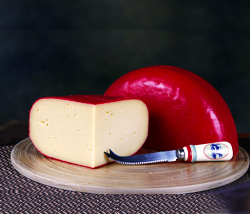 environmental impact.” This cheese fooled me completely. I had ordered a Gouda about nine months old, and expected a product that showed moderate aging (darker, slightly harder paste, more complex taste, more developed aroma). Although this Gouda is nine months old (I checked with the cheesemakers), the paste is of a pale color (with a few moderately-large holes), the aroma is modest, and the flavor is as gentle as a lullaby. One of the cheesemakers attributes these characteristics to the springtime milk used to make this wheel of cheese, remarking that a cheese made with spring milk tends to be lighter in both color and flavor than one made with summer-autumn milk, even when both have been aged for the same length of time. In any case, this is a fine example of a very creamy, very mild Gouda, without the bitter aftertaste I found in most supermarket varieties. If you want to order it from the farm, you must call to order (see the website for more information) and send a check. At present there is no e-commerce or credit card processing). However, gourmet retailer Dorothy Lane Market, which is located near the farm, sells it online. You can visit the farm, in Beallsville, Ohio. environmental impact.” This cheese fooled me completely. I had ordered a Gouda about nine months old, and expected a product that showed moderate aging (darker, slightly harder paste, more complex taste, more developed aroma). Although this Gouda is nine months old (I checked with the cheesemakers), the paste is of a pale color (with a few moderately-large holes), the aroma is modest, and the flavor is as gentle as a lullaby. One of the cheesemakers attributes these characteristics to the springtime milk used to make this wheel of cheese, remarking that a cheese made with spring milk tends to be lighter in both color and flavor than one made with summer-autumn milk, even when both have been aged for the same length of time. In any case, this is a fine example of a very creamy, very mild Gouda, without the bitter aftertaste I found in most supermarket varieties. If you want to order it from the farm, you must call to order (see the website for more information) and send a check. At present there is no e-commerce or credit card processing). However, gourmet retailer Dorothy Lane Market, which is located near the farm, sells it online. You can visit the farm, in Beallsville, Ohio.
Photo courtesy Dorothy Lane Market.
- Dofino Reserve Gouda, Wisconsin. Black wax coating. This is Gouda that has been aged, but there’s no indication of length of aging. There are a few small holes or “eyes” in the paste, which is of a medium yellow hue. There is some character and depth of flavor but a stronger, more bitter aftertaste that verged on being unpleasant. Supermarket purchase.
- Holland’s Family Farm Goudas, Wisconsin. The following five cheeses are all made by this cheesemaker (they make thirteen different flavors of Goudas—The cheeses are made in 13 different varieties: cumin, black pepper, burning nettle, burning mélange, foenegreek, garden herb, Italian herb, mélange, mustard yellow, onion/garlic, smoked and just plain Gouda. They are all sold under the brand Marieke. While all of the cheeses I tried from them were made with pasteurized milk, the company also makes raw milk cheeses (all milk is r-BGH-free). All of their cheeses are farmstead products (a.k.a. boeren kaas). At present, you must e-mail the company to order from them (info@hollandsfamilycheese.com).
|
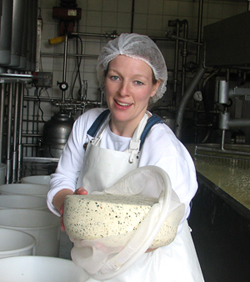
Cheesemaker Marieke Penterman and her award-winning Foenugreek Gouda. Tours are given at the farm in Thorp, Wisconsin. |
| |
At the 2007 U.S. Cheese Championship Contest, the Foenugreek† Gouda won Best of Class in the Open Class for Flavored Semi-soft Cheeses.
†Also spelled fenugreek, an Asian herb (Trigonella foenumgraecum) with aromatic seeds used in making curry and other international dishes. |
- Marieke Garden Herb Premium Gouda, Old (aged 1+ years), Wisconsin. Yellow wax coating. The herbs in this cheese (basil, dill, chervil, parsley, celery, and chives) are represented as green flecks, which prettily decorate the paste. At least in the wedge I received, the herbs were concentrated heavily toward the bottom of the cheese. Slight celery aroma. Very concentrated celery-herbal taste, which, to me, overwhelmed any flavor of the cheese.
- Marieke Mustard Mélange Gouda (aged 4 to 8 weeks),* Wisconsin. Yellow wax coating. A young version of this cheese, with a cream-colored paste and whole mustard seeds distributed nicely throughout. A slight mustard aroma with a subtle mustard presence overall.
- Marieke Mustard Melange Gouda, Old (aged 9 to 12 months),* Wisconsin. Yellow wax coating. The paste of this cheese is of a straw-like color, similar to Parmigiano-Reggiano but not as dark; the paste has mustard seeds scattered throughout. A much stronger mustard aroma than its younger cousin, with a definite, but not biting, mustard presence. Bring on the beer!
|
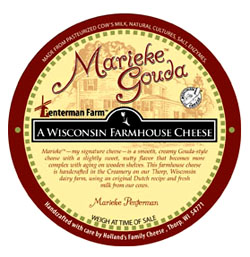 Marieke makes Gouda in 13 flavors. Marieke makes Gouda in 13 flavors.
|
- Marieke Onion Garlic Gouda (aged 4 to 6 months), Wisconsin. Orangey wax coating. Orange flecks show up well against the creamy interior of the cheese. Faint onion aroma. Both onion and garlic tastes dominate here.
- Marieke Plain Premium Gouda, Old (aged 1+ year), Wisconsin.* Yellow wax coating. This Gouda has taken on some of the characteristics of a more mature cheese. The texture is a little harder (though still easy to slice), and the paste is more of an amber than a yellow color; there were a few tyrosines (amino acid crystals) in the paste, too. Not much aroma. Saltier than a younger Gouda, but the salt level isn’t excessive. A solidly good example of a maturing cheese.
- Meadow Stone Farm Di Greta Gouda,* Connecticut. Yellow beeswax coating. A raw milk Gouda from the milk of Jersey cows; mine had been aged for three or four months. A delicate, cream-colored paste with many tiny eyes. Multidimensional flavor and a noticeable tang, which the cheesemaker tells me is due to the cows’ pasture-based diet. A very nice younger Gouda, made by a delightful couple with some passionate views about food.
- Royal Hollandia Gouda, imported from The Netherlands. Red wax coating. Smooth appearance, moderately yellow paste. Buttery texture with some salt and a slight tang but no other real flavor until the aftertaste, which is somewhat bitter and lasting, kicks in. Supermarket purchase.
|
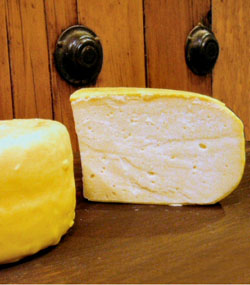 Meadow Stone Farm Gouda shows its “eyes,” or holes. These are formed in a late stage of the cheesemaking process, when bacteria consume lactic acid and release carbon dioxide gas. This forms the bubbles or “holes.” The cheese industry calls these holes “eyes.” Meadow Stone Farm Gouda shows its “eyes,” or holes. These are formed in a late stage of the cheesemaking process, when bacteria consume lactic acid and release carbon dioxide gas. This forms the bubbles or “holes.” The cheese industry calls these holes “eyes.”
|
- Swiss Connection “Intermediate” Aged Flora,* Indiana. No wax coating. Although the cheese is listed as “Gouda” on the website as of this writing, technically, its name has been changed to Flora. This is a raw milk, farmstead (boeren kaas) Gouda from strictly grass-fed cows; mine had been aged for about six months. Deep yellow paste, few eyes, with the easy-slicing texture of a young cheese. Nose-fillingly aromatic in a very pleasant way. There are a multitude of different flavors going on here, though nothing is too sharp, and the layers of tastes are a delight. At present, you must call to order.
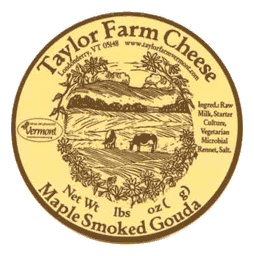 Taylor Farm Maple Smoked Gouda,* Vermont. Thick brown wax coating. Definite smoke aroma. Paste is a pale yellow shot through with many small holes. I was really surprised by this product. Historically, I haven’t cared for smoked cheeses, but the delicate smoky taste here doesn’t knock you over; it merely adds an unexpected and delicious note to the flavor. Taylor Farm Maple Smoked Gouda,* Vermont. Thick brown wax coating. Definite smoke aroma. Paste is a pale yellow shot through with many small holes. I was really surprised by this product. Historically, I haven’t cared for smoked cheeses, but the delicate smoky taste here doesn’t knock you over; it merely adds an unexpected and delicious note to the flavor. - Vintage Special Edition Gouda, imported (origin unspecified). No wax coating. Deep amber paste, much harder and more crumbly than a young Gouda. Strong, mouth-filling flavor, and quite salty, with a caramelized presence. Strong aroma, as well. A few tyrosine crystals provide an occasional bit of crunch. Supermarket purchase. A classic aged Gouda.
- Winchester Cheese Super Aged Gouda,* California. No wax coating. This is a raw milk, farmstead Gouda, or boeren kaas. It looks a little like a Parmigiano-Reggiano, with its darker straw-colored paste, and it cuts very like one, too, in
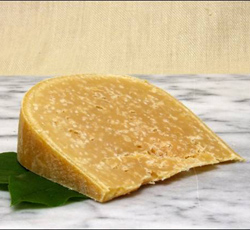 that this cheese is on the crumbly side. It even starts out similar to a Parmigiano in flavor, but the taste turns quickly to a presence just skating on the edge of intense bitterness. EDITOR’S NOTE: We did not eat the same wedge of cheese as the author, but have had it several times and did not find any bitterness—just nuttiness, with sweet and salty tones. While the author does not recommend this cheese (photo at right), we would, based on the different samples we tried. It is aged 15 months or more, and won a Second Place Ribbon in the Gouda Category at last summer’s American Cheese Society Competition. The company also makes a Medium Gouda, aged for at least three months and a Sharp Gouda, aged for at least six months, by which time the tyrosine crystals you can see in the photo begin to develop. that this cheese is on the crumbly side. It even starts out similar to a Parmigiano in flavor, but the taste turns quickly to a presence just skating on the edge of intense bitterness. EDITOR’S NOTE: We did not eat the same wedge of cheese as the author, but have had it several times and did not find any bitterness—just nuttiness, with sweet and salty tones. While the author does not recommend this cheese (photo at right), we would, based on the different samples we tried. It is aged 15 months or more, and won a Second Place Ribbon in the Gouda Category at last summer’s American Cheese Society Competition. The company also makes a Medium Gouda, aged for at least three months and a Sharp Gouda, aged for at least six months, by which time the tyrosine crystals you can see in the photo begin to develop.
Tasting Party
If you want to get to know Gouda, do what I often do with cheeses: have a tasting, alone or with other cheese lovers. It’s a great way to learn about what you like and don’t like (both are equally important), and it’s a lot of fun.
- Buy several different kinds of Goudas, including a mass-produced version and a few farmstead and/or artisan-made varieties, preferably of different ages.
- Cut samples from all of the cheeses and let them come to room temperature, then taste them, starting from the younger, milder Goudas and working your way up.
- Write down your reactions to each cheese (few people can remember without tasting notes).
- Be sure to clear your palate between samples (water and bread or water biscuits like Carr’s are good bets).
You’ll learn more by doing this than you can via most other cheese education methods. If you have leftover cheese, you’ll enjoy it on sandwiches, melts and the other options discussed earlier. Go Gouda!
Sources
Lifestyle Direct, Inc. All rights reserved. Images are the copyright of their respective owners.

|



 the drink of choice with a more mature cheese. For the aged Goudas, our wine editor likes an aged White Burgundy or Chardonnay, which has butterscotch and caramel tones that match those in the aged Gouda; or a dry Riesling. For reds, try a heartier fruity reds, including Cabernet Sauvignon, Merlot, Syrah, Shiraz and Zinfandel. Our editorial director enjoyed St. Francis Sonoma County Cabernet Sauvignon, with black cherry fruit flavor, dark chocolate notes and spicy oak that gave off butterscotch tones unusual in a red wine, and perfect with Gouda.
the drink of choice with a more mature cheese. For the aged Goudas, our wine editor likes an aged White Burgundy or Chardonnay, which has butterscotch and caramel tones that match those in the aged Gouda; or a dry Riesling. For reds, try a heartier fruity reds, including Cabernet Sauvignon, Merlot, Syrah, Shiraz and Zinfandel. Our editorial director enjoyed St. Francis Sonoma County Cabernet Sauvignon, with black cherry fruit flavor, dark chocolate notes and spicy oak that gave off butterscotch tones unusual in a red wine, and perfect with Gouda. 
 environmental impact.” This cheese fooled me completely. I had ordered a Gouda about nine months old, and expected a product that showed moderate aging (darker, slightly harder paste, more complex taste, more developed aroma). Although this Gouda is nine months old (I checked with the cheesemakers), the paste is of a pale color (with a few moderately-large holes), the aroma is modest, and the flavor is as gentle as a lullaby. One of the cheesemakers attributes these characteristics to the springtime milk used to make this wheel of cheese, remarking that a cheese made with spring milk tends to be lighter in both color and flavor than one made with summer-autumn milk, even when both have been aged for the same length of time. In any case, this is a fine example of a very creamy, very mild Gouda, without the bitter aftertaste I found in most supermarket varieties. If you want to order it from the farm, you must call to order (see the website for more information) and send a check. At present there is no e-commerce or credit card processing). However, gourmet retailer
environmental impact.” This cheese fooled me completely. I had ordered a Gouda about nine months old, and expected a product that showed moderate aging (darker, slightly harder paste, more complex taste, more developed aroma). Although this Gouda is nine months old (I checked with the cheesemakers), the paste is of a pale color (with a few moderately-large holes), the aroma is modest, and the flavor is as gentle as a lullaby. One of the cheesemakers attributes these characteristics to the springtime milk used to make this wheel of cheese, remarking that a cheese made with spring milk tends to be lighter in both color and flavor than one made with summer-autumn milk, even when both have been aged for the same length of time. In any case, this is a fine example of a very creamy, very mild Gouda, without the bitter aftertaste I found in most supermarket varieties. If you want to order it from the farm, you must call to order (see the website for more information) and send a check. At present there is no e-commerce or credit card processing). However, gourmet retailer 

 Meadow Stone Farm Gouda shows its “eyes,” or holes. These are formed in a late stage of the cheesemaking process, when bacteria consume lactic acid and release carbon dioxide gas. This forms the bubbles or “holes.” The cheese industry calls these holes “eyes.”
Meadow Stone Farm Gouda shows its “eyes,” or holes. These are formed in a late stage of the cheesemaking process, when bacteria consume lactic acid and release carbon dioxide gas. This forms the bubbles or “holes.” The cheese industry calls these holes “eyes.” Taylor Farm Maple Smoked Gouda
Taylor Farm Maple Smoked Gouda that this cheese is on the crumbly side. It even starts out similar to a Parmigiano in flavor, but the taste turns quickly to a presence just skating on the edge of intense bitterness. EDITOR’S NOTE: We did not eat the same wedge of cheese as the author, but have had it several times and did not find any bitterness—just nuttiness, with sweet and salty tones. While the author does not recommend this cheese (photo at right), we would, based on the different samples we tried. It is aged 15 months or more, and won a Second Place Ribbon in the Gouda Category at last summer’s American Cheese Society Competition. The company also makes a Medium Gouda, aged for at least three months and a Sharp Gouda, aged for at least six months, by which time the tyrosine crystals you can see in the photo begin to develop.
that this cheese is on the crumbly side. It even starts out similar to a Parmigiano in flavor, but the taste turns quickly to a presence just skating on the edge of intense bitterness. EDITOR’S NOTE: We did not eat the same wedge of cheese as the author, but have had it several times and did not find any bitterness—just nuttiness, with sweet and salty tones. While the author does not recommend this cheese (photo at right), we would, based on the different samples we tried. It is aged 15 months or more, and won a Second Place Ribbon in the Gouda Category at last summer’s American Cheese Society Competition. The company also makes a Medium Gouda, aged for at least three months and a Sharp Gouda, aged for at least six months, by which time the tyrosine crystals you can see in the photo begin to develop.